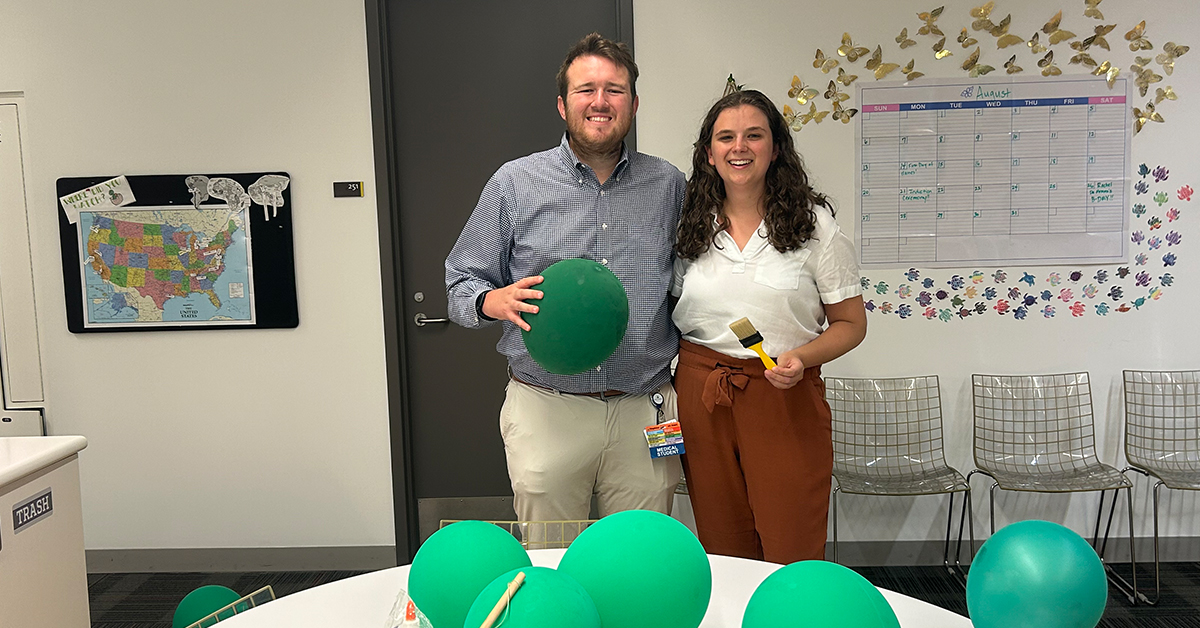School of Medicine Group Brightens Pediatric Patients Spirits with Science Experiments
TEACH is part of a national movement to bring educational programming to children in hospitals, including at Johns Hopkins Children's Center.

With hands-on experiments using items such as lava lamps and baking soda and vinegar volcanoes, the Johns Hopkins University School of Medicine student group TEACH encourages pediatric patients to become more interested in science. The group hosts a monthly science activity at Johns Hopkins Children’s Center, hoping to show that the hospital can be a fun place.
“Throughout the program, the kids get more and more excited about the science,” says Katrina Kuhn, a TEACH member. “Younger kids often want to repeat the experiment over and over. Sometimes, kids who come in really shy end up talking to the medical student volunteers about the science, and sometimes they open up, and that leads to more conversations and connections.”
The TEACH (Together Educating All Children in Hospitals) group is part of an international not-for-profit organization that brings educational programming to hospitals. TEACH’s mission is to create a way for children of all ages to engage with the sciences through fun, interactive experiments.
Kuhn, a third-year medical student, says experiments such as the reactive volcano are good distractions from everything the patients are experiencing. She recalls performing the experiment with a high schooler who had taken advanced placement chemistry — together, they discussed chemistry in detail and talked about equations and reactants.
“It was fun to go that in depth with the science and to see the patient get excited,” Kuhn says. “I was able to challenge her and make her think about the science.”
Peyton Pike, special programs coordinator for the Children’s Center child life department, says the patients love the science projects.
“Similar to all of our child life programs, it’s a chance to have a normalizing experience and just be kids,” Pike says. “The kids go back to their rooms with smiles on their faces. TEACH does a great job of getting kids to remember what it’s like to be a kid and help them enjoy something they are interested in.”
Kuhn says the medical student volunteers always try to approach the patients gently and carefully because they don’t know what the patients have been through that day.
“It’s important to remember that these patients are in tough situations, so this is a much more mellow way of teaching science,” Kuhn says. “We work up to the excitement.”
Group member Meghana Bhimreddy, a third-year medical student, says TEACH is “a great combination of teaching, working with children and sharing a love for science.”
“Since it’s very hands-on, the kids learn more about science than they would reading or watching something,” she says.
Bhimreddy strives to individualize how she teaches each student.
“They all have different energy levels,” she says. “It’s different day by day and patient by patient. Volunteering with this group has taught me a lot about communication with patients. As someone who is interested in working with kids, I know a lot of those communication skills are useful. I’ve also learned to have more patience.”
TEACH member Reed Jenkins says one of his favorite experiments is adding water to instant snow, which is a substance that completely changes shape when wet and has a snow texture. Patients can dye it different colors.
Jenkins says he also enjoys making lava lamps with the patients by using test tubes, vegetable oil, food coloring and water. The children can take the experiments back to their rooms and shake the lamps to reactivate them.
“We try to create the best experience for the kids,” says Jenkins, a third-year medical student. “We can tailor it to the age and patient’s ability. Some patients have less mobility or have an IV. We bring the science to them and make it approachable.”
Pike says that “for medical students, when they’re learning so much of the medical side, it’s important to remember that there’s more to the patients than their diagnosis.”
“TEACH helps the students see the human side of medicine and the psychosocial side of supporting patients and families in the hospital,” she says.
For more information, visit teach4kids.org. Medical students who want to become involved should watch for a form that is emailed monthly.
